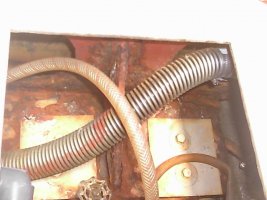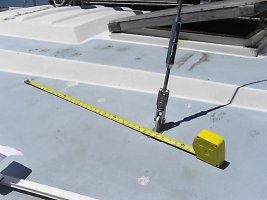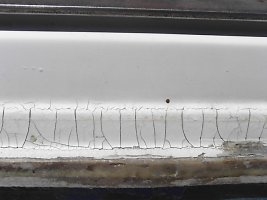Several issues. The hull to deck connection appears to simply be tabbed glass at the joint on the inside, without fasteners. Is this correct?
The rub rails were screwed into the edge of the deck ply, inducing minor de lamination. A lot of crazing exists above the rub rail (picture). I'm wondering if this is joint stress induced. I would be tempted to eliminate the rub rail and glass over the ply deck edge to provide additional joint strength. What I can see of the metal grid under the cabin sole looks very corroded (picture). Is this a major issue? The rear shrouds were moved forward about 39 inches (picture), apparently to tie in with the metal bulkhead below. The traveler (not currently mounted) hardware looks small for a boat this size. The owner thought it was basically "useless", and thought it should be moved aft. The mast is pitted below deck, and I wonder why. Thoughts?
The rub rails were screwed into the edge of the deck ply, inducing minor de lamination. A lot of crazing exists above the rub rail (picture). I'm wondering if this is joint stress induced. I would be tempted to eliminate the rub rail and glass over the ply deck edge to provide additional joint strength. What I can see of the metal grid under the cabin sole looks very corroded (picture). Is this a major issue? The rear shrouds were moved forward about 39 inches (picture), apparently to tie in with the metal bulkhead below. The traveler (not currently mounted) hardware looks small for a boat this size. The owner thought it was basically "useless", and thought it should be moved aft. The mast is pitted below deck, and I wonder why. Thoughts?




